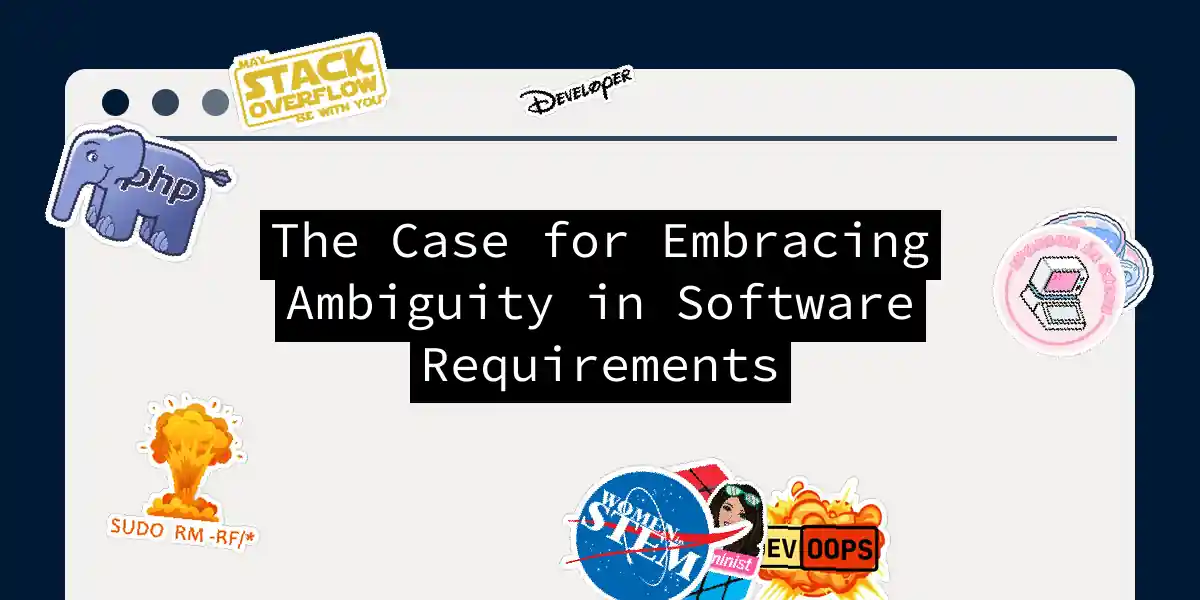The Ambiguity Conundrum: Why Embracing the Unknown Can Be a Game-Changer
In the world of software development, precision is often touted as the holy grail. However, what if I told you that a little bit of ambiguity could actually be a good thing? It sounds counterintuitive, but bear with me as we delve into the complexities of software requirements and why embracing ambiguity might just revolutionize the way we develop software.
The Traditional Aversion to Ambiguity
Historically, software development has been averse to ambiguity. The reasoning is straightforward: computers execute precise sequences of instructions, and any imprecision or ambiguity risks failure or unexpected behavior. This aversion has led to the development of rigorous processes to ensure that every requirement is clear, concise, and unambiguous[1][4].
However, this strict adherence to precision comes with its own set of challenges. For instance, it forces programmers to prematurely commit to specific implementations, limiting the flexibility and reusability of the software. It also overlooks the fact that human communication is inherently ambiguous and context-dependent.
The Real-World Impact of Ambiguous Requirements
Ambiguity in software requirements is not just a minor inconvenience; it can have far-reaching and costly consequences. When requirements are unclear, incomplete, or inadequately detailed, it leads to a cascade of problems. Developers may implement solutions for the wrong problem, testers may expect different behavior, and the end result is a product that fails to meet the intended business requirements[2][5].
Here’s a simple flowchart to illustrate how ambiguity can creep into the development process:
Embracing Ambiguity: The New Frontier
So, how can we make ambiguity work for us instead of against us? The key lies in developing tools and processes that can handle and resolve ambiguity effectively.
Handling Ambiguity in Development Environments
Modern development environments can be designed to work with ambiguous high-level representations of software goals. For example, systems like Keyword Programming and Metafor use natural language processing to understand and disambiguate programmer intentions. These systems can help find existing code that matches the programmer’s goals or infer subgoals from higher-level objectives[1][4].
Here’s an example of how such a system might work in a sequence diagram:
Learning from Examples
Another approach is to use machine learning to learn relationships between ambiguous descriptions and unambiguous code representations. By analyzing large code repositories and their associated natural language descriptions, development environments can learn to map general descriptions to specific implementations. This approach, exemplified by systems like ProcedureSpace, allows the system to learn from examples and improve over time[1].
Involving Developers and Testers Early
Engaging developers and testers early in the requirements definition process can also help mitigate ambiguity. Practices like Dual Track Agile development, which involves repeated testing and validation of requirements, can ensure that false assumptions are caught before they become costly issues[2].
Here’s a state diagram illustrating the Dual Track Agile process:
Conclusion: Embracing the Ambiguity
Embracing ambiguity in software requirements is not about being sloppy or imprecise; it’s about recognizing the natural complexity of human communication and leveraging it to improve the development process. By developing tools that can handle ambiguity, learning from examples, and involving stakeholders early, we can create more flexible, reliable, and reusable software.
In the end, reliable software will know its goals and have multiple strategies to accomplish them, even when things go wrong. It will understand human contexts and goals, and behave appropriately within them. And all of this will be enabled once we acknowledge the strengths of ambiguity and integrate it into our software engineering practices.
So, the next time you’re tempted to chase down every last bit of precision, remember: a little ambiguity can go a long way. It’s time to rethink our aversion to ambiguity and see it as an opportunity rather than a challenge. After all, as the saying goes, “the only constant is change,” and embracing ambiguity is just the beginning of a more adaptive and resilient approach to software development.
